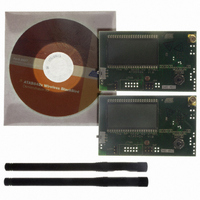ATAB5425-3-WB Atmel, ATAB5425-3-WB Datasheet - Page 10

ATAB5425-3-WB
Manufacturer Part Number
ATAB5425-3-WB
Description
KIT DEMO 345MHZ BLACKBIRD
Manufacturer
Atmel
Type
Transceiver, UHFr
Specifications of ATAB5425-3-WB
Frequency
345MHz
Product
RF Modules
For Use With/related Products
ATA5425
Lead Free Status / RoHS Status
Lead free / RoHS Compliant
Other names
ATAB-5425-3-WB
3. RF Transceiver
3.1
10
Low-IF Receiver
ATA5423/ATA5425/ATA5428/ATA5429
As seen in
PA (Power Amplifier), RX/TX switch, fractional-N frequency synthesizer and the signal process-
ing part with mixer, IF filter, IF amplifier with analog RSSI, FSK/ASK demodulator, data filter, and
data slicer.
In receive mode the LNA pre-amplifies the received signal which is converted down to 226 kHz
(ATA5423/ATA5428) and 235 kHz (ATA5425/ATA5429), filtered and amplified before it is fed
into an FSK/ASK demodulator, data filter, and data slicer. The RSSI (Received Signal Strength
Indicator) signal and the raw digital output signal of the demodulator are available at the pins
RSSI and DEM_OUT. The demodulated data signal Demod_Out is fed to the digital control logic
where it is evaluated and buffered as described in the section
In transmit mode, the fractional-N frequency synthesizer generates the TX frequency which is
fed to the PA. In ASK mode the PA is modulated by the signal PA_Enable. In FSK mode the PA
is enabled and the signal TX_DATA (FSK) modulates the fractional-N frequency synthesizer.
The frequency deviation is digitally controlled and internally fixed to about ±16 kHz (see
4-1 on page 28
section
sion will start only if the synthesizer is locked.
The RX/TX switch can be used to combine the LNA input and the PA output to a single antenna
with a minimum of losses.
Transparent modes without buffering of RX and TX data are also available to allow protocols
and coding schemes other than the internally supported Manchester encoding.
The receive path consists of a fully integrated low-IF receiver. It fulfills the sensitivity, blocking,
selectivity, supply voltage and supply current specification needed to manufacture, for example,
an automotive remote control unit without the use of SAW blocking filter (see
7). In a Base-station Application (5V) the receiver can be used with an additional blocking SAW
front-end filter as shown in
At 433.92 MHz the receiver has a typical system noise figure of 7.0 dB, a system I1dBCP of
-30 dBm and a system IIP3 of –20 dBm. There is no AGC or switching of the LNA needed; thus,
a better blocking performance is achieved. This receiver uses an IF (Intermediate Frequency) of
226 kHz, the typical image rejection is 30 dB and the typical 3 dB IF filter bandwidth is 185 kHz
(f
signal to Gaussian noise ratio of 8 dB for 20 Kbit/s Manchester with ±16 kHz frequency deviation
in FSK mode; thus, the resulting sensitivity at 433.92 MHz is typically –106 dBm at 20 Kbit/s
Manchester.
Due to the low phase noise and spurious emissions of the synthesizer in receive mode
together with the eighth order integrated IF filter, the receiver has a better selectivity and block-
ing performance than more complex double superhet receivers but without external components
and without numerous spurious receiving frequencies.
IF
= 226 kHz ±92.5 kHz, f
“Digital Control Logic”
Figure 1-3 on page
for exact values). The transmit data can also be buffered as described in the
Figure 2.2 on page
lo_IF
. A lock detector within the synthesizer ensures that the transmis-
6, the RF transceiver consists of an LNA (Low-noise Amplifier),
= 133.5 kHz and f
8.
hi_IF
= 318.5 kHz). The demodulator needs a
“Digital Control Logic”
Figure 2-1 on page
4841D–WIRE–10/07
.
Table
(1)












